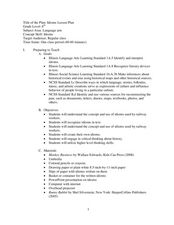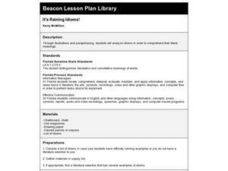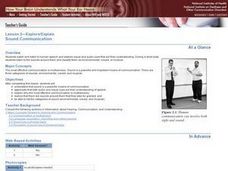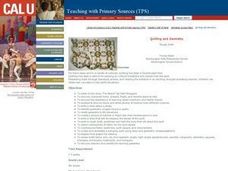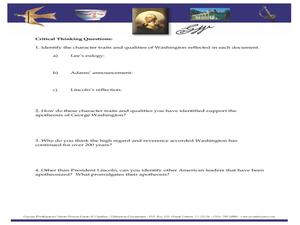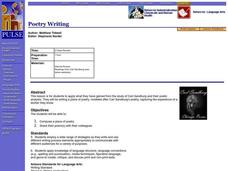Curated OER
Animation Station
Learners examine clay animation. In this technology instructional activity, students use the Internet to investigate the history of clay animation. Learners use story boards and clay figures to create their own "animation."
Curated OER
Storytellers: Bruce Springsteen
Young scholars use the music of Bruce Springsteen to learn literature techniques.
Curated OER
Rock & Roll through Literary Terms: An Upbeat Lyrical Adventure
Students participate in a variety of activities surrounding Rock & Roll music, lyrics, drama and visual art and how they all help demonstrate examples of literary terms. They use Rock & Roll as an effective aid to stimulate their...
Curated OER
Poetic Devices
In this figurative language worksheet, students read and study examples of simile and metaphor. There are 20 questions to be used with Smartboard and 10 questions in which students identify similes or metaphors.
Curated OER
Idioms Lesson Plan
Sixth graders discover idioms. In this idioms lesson, 6th graders evaluate idioms and discover their meaning. Students read Runny Babbit by Shel Silverstein and create unique idioms. Assessment rubric is provided.
Curated OER
"Trails, Rails, and Roads" Lesson 1: "Language and Transportation"
Young scholars, in groups, identify the origins of a number of transportation idioms. They search for current transportation idioms to have a partner explain.
Curated OER
It's Raining Idioms!
Sixth graders analyze idioms and find examples from literature. They choose one idiom and finds pictures or draws pictures to show what it would mean if taken literally and what is it generally thought to mean.
Curated OER
You Don't Say!!
Fourth graders write and respond to sayings throughout the school year. They define the idioms, illustrate them and compare their meanings with other groups in the class.
Curated OER
Hats Off to You!
Pupils research why people wear hats, caps or bonnets. They investigate various occupations, world costumes, sports, or idioms around hats. Students become more aware of cultures different from their own within this lesson plan.
EngageNY
Revisiting Big Metaphors and Themes: Revising and Beginning to Perform Two-Voice Poems
Now that your class has read all of Esperanza Rising, take the time to tackle big metaphors and themes. Pupils will participate in an activity called Chalk Talk, in which they circulate around the room in small groups and add...
Poetry4kids
Simile and Metaphor Lesson Plan
Similes and metaphors are the focus of a poetry lesson complete with two exercises. Scholars read poetry excerpts, underline comparative phrases, then identify whether it contains a simile or metaphor. They then write five...
Poetry4kids
Alliteration and Assonance Lesson Plan
Scholars analyze the poem My Puppy Punched Me in the Eye by Ken Nesbitt in order to locate examples of alliteration and assonance. After reading the poem, alliterative words are underlined and assonant words are circled.
Curated OER
In The Words of Abraham Lincoln...
Students explore the words of Abraham Lincoln. In this Abraham Lincoln lesson, students analyze segments of "The Gettysburg Address," his annual address to Congress in 1862, and his letter to Mrs. Bixby. Students conduct further research...
Curated OER
Jabberwocky-Identifying Adjectives
Elementary learners identify adjectives in sentences. They read the poem "Jabberwocky" by Lewis Carroll and highlight the adjectives. A good supplemental lesson if you are studying Lewis Carroll and/or "Jabberwocky."
Curated OER
Lesson 2-Explore/Explain Sound Communication
Students watch and listen to human speech and explore visual and audio cues that aid their understanding. During a short walk, students listen to the sounds around them and classify them as environmental, voiced, or musical.
Curated OER
Philanthropy Framework
Students become community philanthropists. In this social studies lesson, students learn the definition of philanthropy and apply it to Martin Luther King, Jr. The next day, students complete 3 T-charts for 3 historical figures. Finally,...
Curated OER
The Gettysburg Address
Students become familiar with the Gettysburg Address as well as the historical importance of the document in history. They brainstorm its implications and then in groups translate the language used in the address into modern day...
Curated OER
ACROSTIC POETRY
Students use newspapers or magazines to create an acrostic poem where words are divided into parts of speech.
Curated OER
Geometry and Quilting
Students create a quilt square for a class quilt using at least three, two-dimensional geometric figures. They research and write a brief description of at least two different quilt patterns that they find. Pupils discuss that quilts are...
Curated OER
T'was the Night Before Christmas (Poem)
Students read the poem T'was the Night Before Christmas, and then partner with another student to complete a poem of their own based on the original. The new poem has missing words and students fill in the missing parts of speech like a...
Curated OER
Visual Vocabulary
Students use context clues to determine an understanding for vocabulary words in texts. For this vocabulary lesson plan, students recognize linguistic features in their readings to help them to figure out words.
Curated OER
Lincoln's Legend and Legacy
Students evaluate Lincoln's impact on American History. In this Civil War lesson, students view a film clip of writings about Lincoln. Students take notes and compare how the writings define his legacy. Students write their own poem or...
Curated OER
The Apotheosis ofGeorge Washington
Students examine the image of George Washington. In this Washington presidency lesson, students use the provided analysis handout to analyze the character of Washington conveyed in several pieces of art and speeches. Students share their...
Curated OER
Poetry Writing
Students compose a piece of poetry modeled after the poetry of Carl Sandburg and share their poem(s) with their colleagues. They use a cluster diagram to organize their thoughts and brainstorm their ideas.




